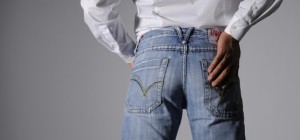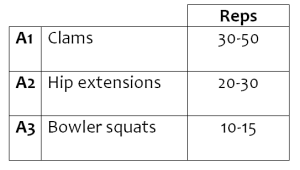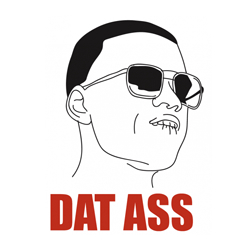From squats to deadlifts, push ups to chin-ups, and all the way to planks, farmer carries and skinny jeans, your glutes are super important.
Well, maybe not so much for the skinny jeans. But hey, I don’t know anyone that thinks pancake glutes look good in those bad boys.

Anyway, I’m a big fan of glutes. Like, a BIG fan. Seriously.
And by the end of this (if you’re not already), I think you will be too.
Stimulation.
This little (yet, slightly confusing at first) table is pretty cool. Check it out.
So, it’s basically a reading of all the muscle activation going on when performing certain exercises.
What I want you to look at first are the muscles I’ve highlighted in blue. These are the abs and the oblique’s (ie. the superficial muscles of the commonly termed “core”).
Even though it’s kinda confusing at first to read, have a look at the acronyms all the way to the far left.
Let’s choose the top row ‘FW’, or, farmers walk. We can see here that the average (mean) muscle activation reads around 15 or so for the rectus abdominus (RRA and LRA).
Always reminds me of the shopping-bag-carry-in-one-trip task.
Now let’s follow along that same row until we get under the ‘RGMED’ and ‘RGMAX’ (the glutes) numbers I’ve highlighted in red.
These numbers are well in the hundreds.
Which is quite a large difference between muscle activation/reliance to complete this certain exercise, right?
But now, follow down the column and check out the differences between the readings in the glute columns compared to the ab’s one.
As you can see, in all the exercises studied in this umm… study, the glutes smoke the abs for activation. And ultimately, for importancy.
Keep in mind that these exercises are performed in strongman lifting competitions that aim to mimic “life” movements. Eg. farmer walks/suitcase carries (shopping bags, luggage, etc). So by taking this into consideration, you can see how important the glutes are in simple day-to-day activities.
Oh and one more thing before we move on, check out the RLD and LLD (the lats) columns. Super high numbers too.
So much for the “core” muscles being the abs, right?
Protection.
So anyway, if you don’t have a high enough level of glute strength, you can suffer knee pain, injuries, etc. But, if you don’t have adequate hip mobility due to tight glutes, you can also suffer that same exact fate.
This is because the movement of our hips – unlike the knees – is reliant on a much larger range of motion.
To give you a better understanding, the knees are known as synovial joints and fall under the hinge category. Meaning, they only move in one dominant range of motion (with the slight ability to internally and externally rotate them).
The hips, on the other hand, fall under what is known as the multiaxial joint category. Meaning, they can and really want to move through a much larger range of motion.
Compensation.
So, if you’re lacking basic movement and an adequate range of motion in certain mobile joints (like the shoulder, hip, upper torso), the more stable joints (like the elbow, knee, lower back) on either side of the restricted area are forced to pick up the slack.
And when these less-than-ideal stable joints take the lead, a higher risk of falling into a compensation pattern becomes a lot more prevalent.
After a while, dodgy patterns can be established. And this can then lead to muscle imbalances, weakness, tightness and of course, can result in injuries/pain.
Inactivation.
One way we can test glute inactivation is from a simple squat assessment upon ourselves. If our hips have more of a tendency to deviate towards one side throughout the movement, chances are high that the opposite side is the troubled area.
Restriction.
There’s always a reason as to why we can fall into dodgy movement patterns. And it’s not just the fact that we may sit at a computer desk all day cramping up those goddamn hip flexors.
We can trace an inactive glute back down the chain of events to sometimes simply being a result of tight adductor muscles (or, your groin).
But, don’t forget, that tight adductor muscles aren’t just tight just because they feel like being tight. They’re tight for a reason. And we can sometimes trace this right back to being a result of upset breathing patterns or even posture (stable and dynamic) related.
Now, I know what you’re thinking: can we rectify this fiasco?
Definitely.
Activation.
Following the addressing (and acceptance) of what is actually causing our tight adductor muscles/hip flexors, we can then start to wake back up these ultimate muscles.
And one exercise I love to use that targets both the rectification AND combats the tightness of our adductors is the good ol’ clam.
The trick with this one is to stay in a neutral alignment (remember the TT?) and try to create movement from just your glute region (you can also add weight to this by using ankle/wrist straps once your external rotators are stronger).
Throughout the set, you’ll also find that your range of motion will increase. Pretty cool, right?
Another nice and basic one that a lot of people do wrong is the hip extension (or, glute bridge).
The key with this one is to again use your TT knowledge and create tension through the glutes to create the lift and not arch through your back.
Following on from these exercises is another one that also implements a focus on your knee tracking ability.
With this one, aim to find a stretch in your glutes whilst keeping your knee tracking over your toes. Return to the start by creating tension through the glute and focus on keeping your torso upright.
Domination.
What you’ll find is, when dominating through your glutes and switching them on optimally, the stress on your compensation areas (like your lower back) will ease off. And over time, the tightness/pain you may feel in your hip flexors/adductors/etc. can actually disappear. Also pretty cool, right?
So anyway, let’s put what you now know together, and give you a little epic glute activation mini-circuit that you can implement into your training straight away.

Repeat two to three times in a row as a superset.
Note: you should definitely be feeling a fire in your glute by at least the 20th clam rep on the first set. If you’re not, line up your spine better, TT, and focus on your hips not deviating to create the movement.
Try this out and drop any Q’s below.
References:
McGill SM, et al. Comparison of different strongman events: trunk muscle activation and lumbar spine motion, load, and stiffness. J Strength Cond Res. 2009 Jul;23(4):1148-61.



